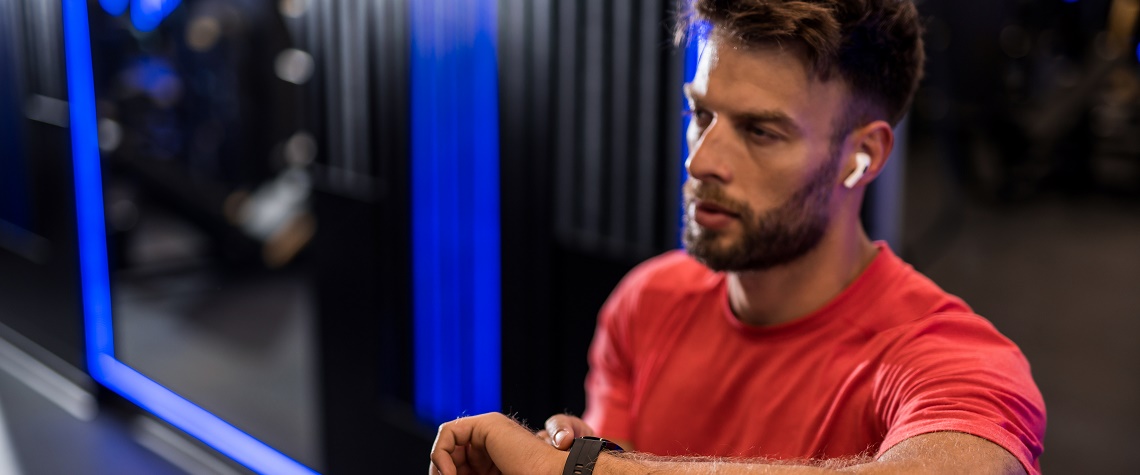Health horizons
DNA dividends

The shift towards more proactive and personalised healthcare is underpinned by data, wearables and other digital technologies which enable a more joined-up approach to care and support.
Dr Rishi Patel, Bupa’s Head of Health Services Proposition and former NHS public health doctor says, “Data from genomic advances, pharmacogenomics and personalised risk scoring will provide each of us with a clear road-map to better health.
“This information will help us to steer clear of preventable health conditions and ensure the fastest route to a diagnosis when problems arise — but only if we have the tools and motivation to take this proactive approach.”
Fitness and wellbeing trackers; wearable medical devices which monitor heart rate, oxygen levels and other metrics; and devices such as insulin pumps which improve treatment, can make a huge difference.
Dr Caroline Wood Head of Customer Intelligence, Bupa Global and UK, says, “Having this sort of real-time feedback, coupled with personalised information about your genetic risk of developing a problem, can be incredibly motivating.
“It’s much easier to take proactive steps to protect your health when you can see clear evidence that it will benefit you personally.”
Behaviour change
Researchers from the University of Birmingham who analysed 20 studies looking at these technologies found, “Wearables can empower individuals by assisting with diagnosis, behaviour change and self-monitoring.”1
Some of the benefits they identified include:
- Greater convenience
- Fewer appointments
- Richer data and all-day feedback
- Increased motivation for behaviour change
Meta-analysis of 39 studies with almost 164,000 participants, which was published in The Lancet Digital Health, confirms that activity trackers improve physical activity, body composition and fitness levels. 2
On average, people who used these wearables walked an additional 1,800 steps a day, spent 40 minutes more each day walking and lost a kilogram in bodyweight.
Personalised digital care
Using data and digital technology in this way is sometimes called participatory health informatics (PHI) as it encourages individuals to take an active role in decisions around disease prevention and healthcare.3
One recent study defines this as “Informed and connected patients altering the traditional course of health and wellbeing management through greater information availability, social connectedness and support, collaboration, choice, and autonomy over health decisions.”
Bupa’s ConnectedCare, which uses joined-up care to deliver better outcomes, shows the dividends this can deliver — for both employees and organisations.
ConnectedCare links our nationwide network of clinics and hospitals, digital healthcare app and integrated treatment pathways to deliver seamless and swift access to the right care.
Same day reassurance
This includes specialist cancer centres which provide same day all-clear reassurance or referral for treatment or further tests.
Physiotherapy can be accessed within 48 hours, and in 80% of cases this happens within 24 hours 4 — when it will deliver the greatest benefits. A study published last year found that early treatment improved outcomes for pain and mobility and reduced sickness absence.5
Early intervention also prevents unhelpful pain avoidance strategies — such as reduced physical activity and compensatory postures — which increase the risk of prolonged musculoskeletal issues.
With the Office of National Statistics estimating that 23.3 million working days are lost annually due to these conditions, the potential business benefits of better care, and personalised support to prevent them, are enormous.6
Better outcomes
My Bupa is another real-world example of digital technology delivering better outcomes. This one-stop app enables users to access personalised services and information through Blua digital health care and other resources.
This includes proactive support such as on-demand fitness and wellbeing plans, classes and other resources, as well as the convenience of virtual appointments and remote access to GPs, physiotherapists and mental health specialists.
Rishi says, “Looking ahead, the potential benefits of mining data and using digital technologies to deliver proactive advice to protect against ill-health and personalised care when problems arise, are enormous.
Sensitivity to medicines
“What was once science fiction, is fast becoming science fact. In the not-too-distant future all babies could have their genome sequenced at birth to look for inherited disease, their sensitivity to medicines and to identify the diseases and conditions they are likely to develop.”
This is already beginning to happen, with Genomics England recently launching a pilot to sequence the genomes of 100,000 newborns in an effort to improve our ability to diagnose and treat those born with genetic conditions. 7
Bupa know-how
And while the technology is still at an early stage, artificial intelligence (AI) is already able to identify some genetic disorders from facial analysis alone, identify gene variants which drive disease and predict how some cancers will progress. 8
The potential gains from using AI to analyse large data sets, assess diagnostics and identify patterns in health and lifestyle behaviours is enormous.
But in the here and now, Bupa’s experts will continue to assess these rapidly evolving technologies, analyse our wealth of health and claims data and utilise our clinical know-how to support health and wellbeing in the workplace and for our customers.
1 https://pmc.ncbi.nlm.nih.gov/articles/PMC9330198/
2 https://www.thelancet.com/journals/landig/article/PIIS2589-75002200111-X/fulltext
3 https://pubmed.ncbi.nlm.nih.gov/33622168/
5 https://onlinelibrary.wiley.com/doi/full/10.1002/msc.1924
